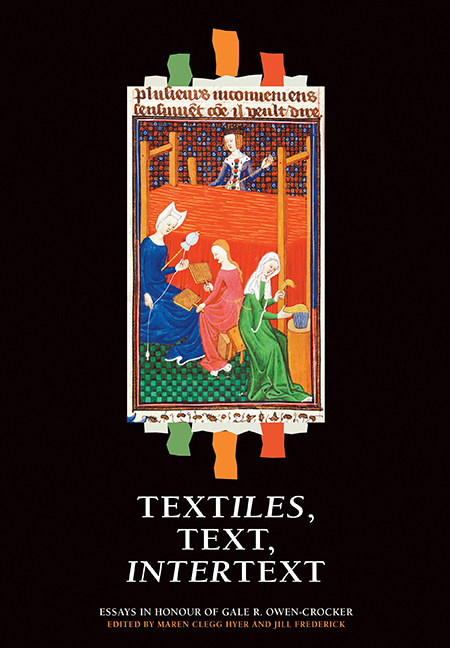Book contents
- Frontmatter
- Contents
- List of Illustrations
- List of Abbreviations
- Introduction
- A Personal Recollection
- List of publications of Gale R. Owen Crocker
- Part I Textile
- 1 The Language of Dress and Textiles in Wills of the Old English Period
- 2 Opus What? The Textual History of Medieval Embroidery Terms and Their Relationship to the Surviving Embroideries c. 800–1400
- 3 Intertextuality in the Bayeux Tapestry: The Form and Function of Dress and Clothing
- 4 Birds of a Feather: Magpies in the Bayeux Tapestry?
- 5 Threads and Needles: The Use of Textiles for Medical Purposes
- Part II Text
- Part III Intertext
- Index
- Tabula Gratulatoria
1 - The Language of Dress and Textiles in Wills of the Old English Period
from Part I - Textile
Published online by Cambridge University Press: 05 July 2016
- Frontmatter
- Contents
- List of Illustrations
- List of Abbreviations
- Introduction
- A Personal Recollection
- List of publications of Gale R. Owen Crocker
- Part I Textile
- 1 The Language of Dress and Textiles in Wills of the Old English Period
- 2 Opus What? The Textual History of Medieval Embroidery Terms and Their Relationship to the Surviving Embroideries c. 800–1400
- 3 Intertextuality in the Bayeux Tapestry: The Form and Function of Dress and Clothing
- 4 Birds of a Feather: Magpies in the Bayeux Tapestry?
- 5 Threads and Needles: The Use of Textiles for Medical Purposes
- Part II Text
- Part III Intertext
- Index
- Tabula Gratulatoria
Summary
Relationships in academic life are often reminiscent of those in families: what begins as a quasi-parental relationship with a supervisor often shifts into a more equal and collegial connection. I was lucky enough to be a junior colleague of Gale's when she was head of the Department of English and American Studies at the University of Manchester. She invited me to be co-investigator on a project she was planning that became the website and database, “The Lexis of Cloth and Clothing in Britain c. 700–1450: Origins, Identification, Contexts and Change (LexP)”. I then had the pleasure of inviting her to be co-investigator on my follow-up project “Medieval Dress and Textile Vocabulary in Unpublished Sources”, the main outcome of which is Medieval Dress and Textiles in Britain: A Multilingual Sourcebook (hereafter Sourcebook). This paper makes use of information and data from both of these projects to explore the language with which garments and textiles are represented in wills written in England in the Old English period. I focus on two issues prompted by these texts: first, the kinds of evidence the wills offer about the multilingual situation of medieval Britain; and second, whether we can discern linguistic structures used in the description of garments and cloth that seem to be specific to this text type.
Texts
The initial aim of the “Medieval Dress and Textile Vocabulary” project was to transcribe and edit extracts from two sets of documents dealing with cloth and clothing in the medieval period: accounts relating to the Royal Wardrobe, and petitions to king, council, and Parliament from the thirteenth and fourteenth centuries. The further aim was to contextualise this material within a range of examples of different text types, bringing together selections from non-literary text types as well as some literary texts to produce an anthology offering textual extracts from the Old and Middle English periods and reflecting the multilingual situation of medieval Britain. The text types have in common their concern with textiles, clothing, armour, and furnishings. I was interested in examining the particular ways which the terminology relating to the semantic field of DRESS AND TEXTILES was deployed in medieval England, and so planned to use the text base we collected for the project as a set of data with which to test theories about linguistic choices in the different text types.
- Type
- Chapter
- Information
- Textiles, Text, IntertextEssays in Honour of Gale R. Owen-Crocker, pp. 27 - 42Publisher: Boydell & BrewerPrint publication year: 2016



